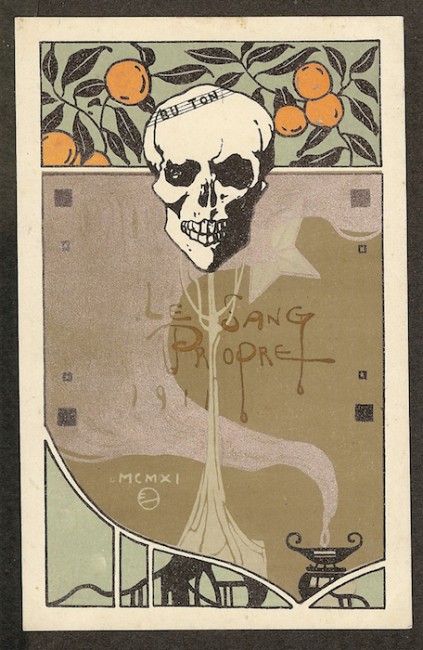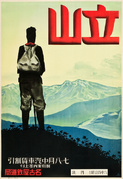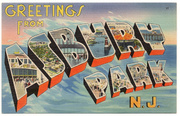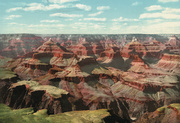
The recent exhibition at the Asian Art Museum titled “Looking East: How Japan Inspired Monet, Van Gogh, and Other Western Artists” shines a light on how the opening of Japan to the West in the 1850s spurred the late 19th-century European preoccupation for all things Japanese. But inspiration also traveled in the other direction, as seen in these turn-of-the-20th-century Japanese postcards from the collection of U.S. postcard collector Ken Reed.
According to Reed, who cautions that he’s “not a scholar,” the European Art Nouveau aesthetic found its way to the Land of the Rising Sun via a group of Japanese artists who attended the 1900 Exposition Universelle in Paris. “They brought Art Nouveau back with them and incorporated it into what was happening in Japan.”
As a former postcard and stamp dealer, Reed the collector could have gone down the latter path, but he chose postcards instead. “You don’t have to have perfect perforations and rare cancellations,” he says of the exacting standards of stamp collecting. “With postcards, you get to focus on the art side of the card instead of where it went and how it got there. That’s what I like about them.”
Most of the postcards show here—a small sample of the hundreds in this genre he owns—are the standard 5 1/2 by 3 1/2 inches and were printed between 1900 and 1920, although he believes the OSK (for Osaka Shosen Kaisha) ship postcard, #15, is probably from the 1920s. “They made those in huge quantities,” Reed says of these paper souvenirs, which were mailed to loved ones and friends back home by passengers aboard vessels like the Tacoma Maru. “It makes them fun to collect because there are a lot in the marketplace. I’ve got about 1,000 or so.”
Still, Reed stresses, his Japanese postcard collection is nothing compared to the horde amassed by the king of all Japanese postcard collectors, billionaire cosmetics heir Leonard Lauder, who gave his collection of more than 20,000 Japanese postcards to Boston’s Museum of Fine Arts in 2002. And even 20,000 is but a tip of the Japanese postcard iceberg, which is why Reed suspects he owns cards that were probably never cataloged by the minions who no doubt helped Lauder organize his purchases over the years.
Take the rather ominous image of the skull hovering above the French words “Le Sang Propre,” its cranium framed by a background of oranges. In Japan, oranges are often a symbol of the New Year, and New Year’s cards are hugely popular, so that’s probably what this card was, but why the skull? And why the reference to “Le Sang,” which is “blood” in English, or “Propre,” which can mean “clean” or “own” or “proper,” depending on the context?
“It’s an interesting card,” Reed says matter-of-factly. “It doesn’t match anything else I have in my collection, and Lauder doesn’t mention it in his book. But I’m not really an expert. I just like it.”
(Thanks to Nicole Mullen at SFO Museum for introducing us to Ken Reed.)
















 When Postcards Made Every Town Seem Glamorous, From Asbury Park to Zanesville
When Postcards Made Every Town Seem Glamorous, From Asbury Park to Zanesville
 Mysterious Railway Posters Depict the Dreamy Allure of Deco-Era Japan
Mysterious Railway Posters Depict the Dreamy Allure of Deco-Era Japan When Postcards Made Every Town Seem Glamorous, From Asbury Park to Zanesville
When Postcards Made Every Town Seem Glamorous, From Asbury Park to Zanesville In Living Color: The Forgotten 19th-Century Photo Technology that Romanticized America
In Living Color: The Forgotten 19th-Century Photo Technology that Romanticized America Japanese PostcardsWhen Japan opened its borders to trade with the West in the mid-19th centur…
Japanese PostcardsWhen Japan opened its borders to trade with the West in the mid-19th centur… PostcardsPostcards, sometimes spelled out in two words as "post cards," emerged duri…
PostcardsPostcards, sometimes spelled out in two words as "post cards," emerged duri… Asian AntiquesAsian cultures are among the oldest in the world and are associated with so…
Asian AntiquesAsian cultures are among the oldest in the world and are associated with so… Mari Tepper: Laying it on the Line
Mari Tepper: Laying it on the Line Nice Ice: Valerie Hammond on the Genteel Charm of Vintage Canadian Costume Jewelry
Nice Ice: Valerie Hammond on the Genteel Charm of Vintage Canadian Costume Jewelry How Jim Heimann Got Crazy for California Architecture
How Jim Heimann Got Crazy for California Architecture Modernist Man: Jock Peters May Be the Most Influential Architect You've Never Heard Of
Modernist Man: Jock Peters May Be the Most Influential Architect You've Never Heard Of Meet Cute: Were Kokeshi Dolls the Models for Hello Kitty, Pokemon, and Be@rbrick?
Meet Cute: Were Kokeshi Dolls the Models for Hello Kitty, Pokemon, and Be@rbrick? When the King of Comedy Posters Set His Surreal Sights on the World of Rock 'n' Roll
When the King of Comedy Posters Set His Surreal Sights on the World of Rock 'n' Roll How One Artist Makes New Art From Old Coloring Books and Found Photos
How One Artist Makes New Art From Old Coloring Books and Found Photos Say Cheese! How Bad Photography Has Changed Our Definition of Good Pictures
Say Cheese! How Bad Photography Has Changed Our Definition of Good Pictures Middle Earthenware: One Family's Quest to Reclaim Its Place in British Pottery History
Middle Earthenware: One Family's Quest to Reclaim Its Place in British Pottery History Fancy Fowl: How an Evil Sea Captain and a Beloved Queen Made the World Crave KFC
Fancy Fowl: How an Evil Sea Captain and a Beloved Queen Made the World Crave KFC
Leave a Comment or Ask a Question
If you want to identify an item, try posting it in our Show & Tell gallery.